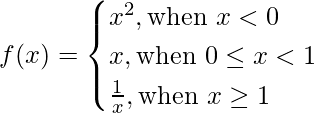Pregunta 1. Si f(x)=x 2 -3x+4, entonces encuentra los valores de x que satisfacen la ecuación f(x)=f(2x+1).
Solución:
Tenemos,
f(x)=x 2 -3x+4
Ahora,
f(2x+1)=(2x+1) 2 -3(2x+1)+4
f(2x+1)=4x 2 +1+4x-6x-3+4
f(2x+1)=4×2 -2x+ 2
se da que
f(x)=f(2x+1)
x2 -3x+4=4×2 -2x + 2
0=4x 2 -x 2 -2x+3x+2-4
3x 2 +x-2=0
3x 2 +3x-2x-2=0
3x(x+1)-2(x+1)=0
(x+1)(3x-2)=0
x+1=0 o 3x-2=0
x=-1 o x=2/3
Por lo tanto, el valor de x son -1 y 2/3.
Pregunta 2. Si f(x)=(xa) 2 (xb) 2 , encuentra f(a+b).
Solución:
Tenemos,
f(x)=(xa) 2 (xb) 2
Ahora encontremos f(a+b)
f(a+b)=(a+ba) 2 (a+bb) 2
f(a+b)=b 2 a 2
Por lo tanto, f(a+b)=(ba) 2
Pregunta 3. Si y=f(x)=(ax-b)/(bx-a), demuestre que x=f(y).
Solución:
Dado,
y=f(x)=(ax-b)/(bx-a)
Como sabemos, f(y)=(ay-b)/(by-a)
Probemos que x=f(y).
Tenemos,
y=(ax-b)/(bx-a)
Al multiplicar en cruz,
y(bx-a)=ax-b
bxy-ay=ax-b
bxy-ax=ay-b
x(by-a)=ay-b
x=(ay-b)/(por-a)
Por lo tanto, x=f(y)
Por lo tanto probado.
Pregunta 4. Si f (x) = 1 / (1 – x), demuestre que f [f {f (x)}] = x.
Solución:
Dado:
f (x) = 1 / (1 – x)
Probemos que f [f {f (x)}] = x.
En primer lugar, resolvamos para f {f (x)}.
f {f (x)} = f {1/(1 – x)}
= 1 / 1 – (1/(1 – x))
= 1 / [(1 – x – 1)/(1 – x)]
= 1 / (-x/(1 – x))
= (1 – x) / -x
= (x – 1) / x
∴ f {f (x)} = (x – 1) / x
Ahora, resolveremos para f [f {f (x)}]
f [f {f (x)}] = f [(x-1)/x]
= 1 / [1 – (x-1)/x]
= 1 / [(x – (x-1))/x]
= 1 / [(x – x + 1)/x]
= 1 / (1/x)
∴ f [f {f (x)}] = x
Por lo tanto probado.
Pregunta 5. Si f (x) = (x + 1) / (x – 1), demuestre que f [f (x)] = x.
Solución:
Dado:
f (x) = (x + 1) / (x – 1)
Tenemos que demostrar que f [f (x)] = x.
f [f (x)] = f [(x+1)/(x-1)]
= [(x+1)/(x-1) + 1] / [(x+1)/(x-1) – 1]
= [[(x+1) + (x-1)]/(x-1)] / [[(x+1) – (x-1)]/(x-1)]
= [(x+1) + (x-1)] / [(x+1) – (x-1)]
= (x+1+x-1)/(x+1-x+1)
= 2x/2
= x
∴ f [f (x)] = x
Por lo tanto probado.
Pregunta 6. Si

Encontrar:
(yo) f (1/2)
(ii) f (-2)
(iii) f (1)
(iv) f (√3)
(v) f (√-3)
Solución:
(yo) f (1/2)
Cuando, 0 ≤ x ≤ 1, f(x) = x
∴ f (1/2) = 1/2
(ii) f (-2)
Cuando, x < 0, f(x) = x 2
f (–2) = (–2) 2
= 4
∴ f (–2) = 4
(iii) f (1)
Cuando, x ≥ 1, f (x) = 1/x
f(1) = 1/1
∴f(1) = 1
(iv) f (√3)
Tenemos √3 = 1.732 > 1
Cuando, x ≥ 1, f (x) = 1/x
∴ f (√3) = 1/√3
(v) f (√-3)
Sabemos que √-3 no es un número real y que la función f(x) está definida solo cuando x ∈ R.
∴ f (√-3) no existe.
Pregunta 7. Si f(x)=x 3 -(1/x 3 ), demuestra que f(x)+f(1/x)=0.
Solución:
Tenemos,
f(x)=x 3 -(1/x) 3 —(i)
Ahora,
f(1/x)=(1/x) 3 -(1/(1/x) 3 )
f(1/x)=(1/x) 3 -x 3 —(ii)
Sumando las ecuaciones (i) y (ii), obtenemos
f(x)+f(1/x) = (x 3 -1/x 3 )+(1/x 3 -x 3 )
f(x)+f(1/x)=x 3 -x 3 +1/x 3 -1/x 3
f(x)+f(1/x)=0
Por lo tanto, probado.
Pregunta 8. Si f(x)= 2x/(1+x 2 ), demuestra que f(tan θ)=sen 2θ .
Solución.
Tenemos,
f(x)=2x/(1+x 2 )
Ahora,
f(tan θ)=2(tan θ)/(1+tan 2 θ)
f(tan θ)=sen 2θ (Porque, sen 2θ = 2(tan θ)/(1+tan 2 θ))
Por lo tanto, probado.
Pregunta 9. Si f(x)=(x-1)/(x+1), entonces demuestre que
i) f(1/x)=-f(x)
ii) f(1/(-x))=-1/f(x)
Solución.
i) Tenemos,
f(x)=(x-1)/(x+1)
Ahora,
f(1/x)=((1/x)-1)/((1/x)+1)
f(1/x)=((1-x)/x)/((1+x)/x)
f(1/x)=(1-x)/(1+x)=f(-x)
Por lo tanto, probado.
ii) Tenemos,
f(x)=(x-1)/(x+1)
Ahora,
f(1/(-x))= ((1/(-x))-1)/((1/(-x))+1)
f(1/(-x))=((1+x)/(-x))/((1-x)/(-x))
f(1/(-x))=(1+x)/(1-x)
f(1/(-x))=(-1)/((x-1)/(x+1))
f(1/(-x))=-1/f(x)
Por lo tanto, probado.
Pregunta 10. Si f(x)=(ax n ) 1/n ,a>0 y n ∈ N, entonces demuestre que f(f(x))=x para todo x.
Solución.
Tenemos,
Pregunta 11. Si para x distinto de cero, af(x)+bf(1/x) = 1/x – 5, donde a ≠ b, entonces encuentre f(x).
Solución.
Tenemos,
-(i)
—(ii)
Sumando las ecuaciones (i) y (ii), obtenemos

—(iii)
Restar la ecuación (ii) de la ecuación (i)
—(iv)
Sumando las ecuaciones (iii) y (iv), obtenemos
Por lo tanto,
Publicación traducida automáticamente
Artículo escrito por ayushharwani2011 y traducido por Barcelona Geeks. The original can be accessed here. Licence: CCBY-SA
![Rendered by QuickLaTeX.com f(x)=(a-x^n)^\frac{1}{n}, a>0\\ \newline \\ Now, \\ f(f(x))=f(a-x^n)^\frac{1}{n}\\ f(f(x))=[a-\{(a-x^n)^\frac{1}{n}\}^n]^\frac{1}{n} \\ f(f(x))=[a-(a-x^n)]^\frac{1}{n}\\ f(f(x))=[a-a+x^n]^\frac{1}{n}\\ f(f(x))=(x^n)^\frac{1}{n}\\ f(f(x))=x\\ Hence, proved](https://www.geeksforgeeks.org/wp-content/ql-cache/quicklatex.com-cbf49f4813d2ad7666611839655398e7_l3.png)

![Rendered by QuickLaTeX.com 2f(x)=\frac{1}{a+b}[\frac{1}{x}+x-10]+\frac{1}{a-b}[\frac{1}{x}-x]\\ 2f(x)=\frac{(a-b)[\frac{1}{x}+x-10]+(a+b)[\frac{1}{x}-x]}{(a+b)(a-b)} \\ 2f(x)=\frac{\frac{a}{x}+ax-10a-\frac{b}{x}-bx+10b+\frac{a}{x}-ax+\frac{b}{x}-bx}{a^2-b^2} \\ 2f(x)=\frac{\frac{2a}{x}-10a+10b-2bx}{a^2-b^2} \\ f(x)=\frac{1}{a^2-b^2}\times\frac{1}{2}[\frac{2a}{x}-10a+10b-2bx]\\ f(x)=\frac{1}{a^2-b^2}[\frac{a}{x}-5a+5b-bx]](https://www.geeksforgeeks.org/wp-content/ql-cache/quicklatex.com-8a7fa75719fb7844e97a763b99a4b66e_l3.png)